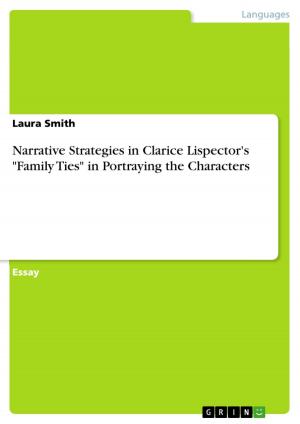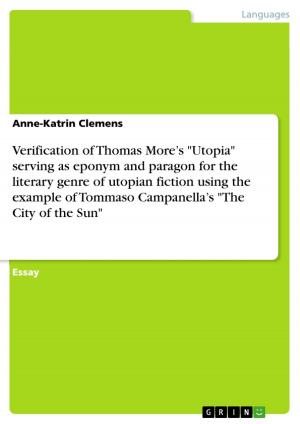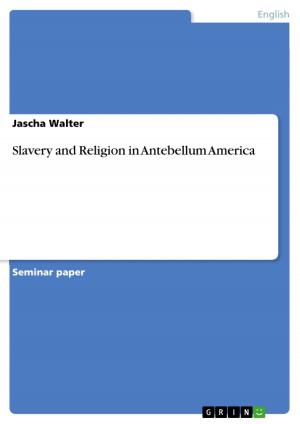The Phenomenon 'Harry Potter' - The Secret of its success
The Secret of its success
Fiction & Literature, Literary Theory & Criticism, British| Author: | Isabel Zosig | ISBN: | 9783638268363 |
| Publisher: | GRIN Publishing | Publication: | April 15, 2004 |
| Imprint: | GRIN Publishing | Language: | English |
| Author: | Isabel Zosig |
| ISBN: | 9783638268363 |
| Publisher: | GRIN Publishing |
| Publication: | April 15, 2004 |
| Imprint: | GRIN Publishing |
| Language: | English |
Seminar paper from the year 2003 in the subject English Language and Literature Studies - Literature, grade: 2 (B), University of Bamberg (Centre for British Studies), course: Introdution to british media and communication science, language: English, abstract: At the age of six, Joanne Kathleen Rowling2 wrote her first short story about a rabbit named Rabbit, who had the measles and was visited by his friends. Amongst them was a little bee called Miss Bee. However, she never told anyone about her 'burning ambition'3 to become a writer, not even Ms Shephard, her English teacher at Wyedean Comprehensive School. Ms Shephard was a great influence on young Joanne as 'she inspired trust'4. Shephard's comments on Harry Potter and the Philosopher's Stone 'meant more to [Joanne Rowling] than any newspaper reviews'5. After finishing secondary school and her studies in French and Classics at Exeter University, Joanne Rowling started to work as a research asssistant at Amnesty International which was a 'very, very interesting place to work'6, but at the same time a huge mistake, because Joanne Rowling admits that as a secretary she would be anybody's 'worst nightmare'7. It was during a delayed train journey from Manchester to King's Cross Station in London, when she was obviously hit by magic. The story about a little orphan named Harry Potter, who has to live with his old-fashioned relatives and finds out that he is a wizard, came to her mind. And because she had no pen or notebook with her, she had to think it. So, Hogwarts - School of Witchcraft and Wizardry came to life in her imagination, and as she invented it, it 'felt like research'8. 'It was a question of discovery why Harry was where he was, why his parents were dead'9. At the end of the journey she knew 'it was going to be a seven-book series'10. The next five years, while she moved to Portugal, got married, had a baby, got divorced and moved back to Britain, she continued writing the first book of the series Harry Potter and the Philosopher's Stone (HP1)11 which she finished in 1995. 2 see Picture 1 3 Lindsey Fraser, Conversations with J.K. Rowling, New York 2001, p.22. 4 ibid, p. 19. 5 ibid, p. 19. 6 ibid, p. 36. 7 ibid, p. 35. 8 ibid, p. 39. 9 ibid, p. 39. 10 ibid, pp. 39. 11 see Picture 2
Seminar paper from the year 2003 in the subject English Language and Literature Studies - Literature, grade: 2 (B), University of Bamberg (Centre for British Studies), course: Introdution to british media and communication science, language: English, abstract: At the age of six, Joanne Kathleen Rowling2 wrote her first short story about a rabbit named Rabbit, who had the measles and was visited by his friends. Amongst them was a little bee called Miss Bee. However, she never told anyone about her 'burning ambition'3 to become a writer, not even Ms Shephard, her English teacher at Wyedean Comprehensive School. Ms Shephard was a great influence on young Joanne as 'she inspired trust'4. Shephard's comments on Harry Potter and the Philosopher's Stone 'meant more to [Joanne Rowling] than any newspaper reviews'5. After finishing secondary school and her studies in French and Classics at Exeter University, Joanne Rowling started to work as a research asssistant at Amnesty International which was a 'very, very interesting place to work'6, but at the same time a huge mistake, because Joanne Rowling admits that as a secretary she would be anybody's 'worst nightmare'7. It was during a delayed train journey from Manchester to King's Cross Station in London, when she was obviously hit by magic. The story about a little orphan named Harry Potter, who has to live with his old-fashioned relatives and finds out that he is a wizard, came to her mind. And because she had no pen or notebook with her, she had to think it. So, Hogwarts - School of Witchcraft and Wizardry came to life in her imagination, and as she invented it, it 'felt like research'8. 'It was a question of discovery why Harry was where he was, why his parents were dead'9. At the end of the journey she knew 'it was going to be a seven-book series'10. The next five years, while she moved to Portugal, got married, had a baby, got divorced and moved back to Britain, she continued writing the first book of the series Harry Potter and the Philosopher's Stone (HP1)11 which she finished in 1995. 2 see Picture 1 3 Lindsey Fraser, Conversations with J.K. Rowling, New York 2001, p.22. 4 ibid, p. 19. 5 ibid, p. 19. 6 ibid, p. 36. 7 ibid, p. 35. 8 ibid, p. 39. 9 ibid, p. 39. 10 ibid, pp. 39. 11 see Picture 2















